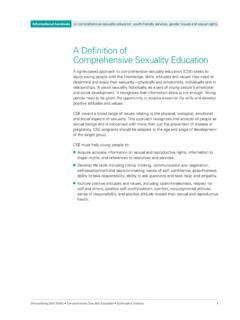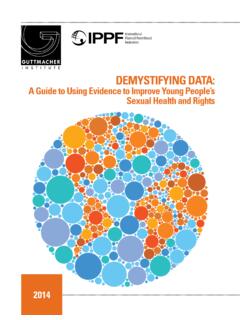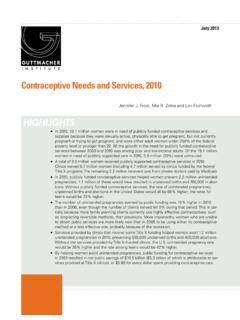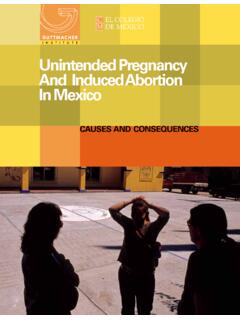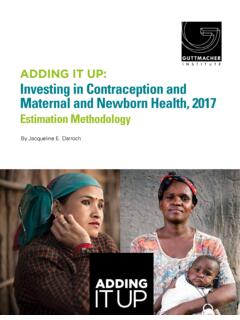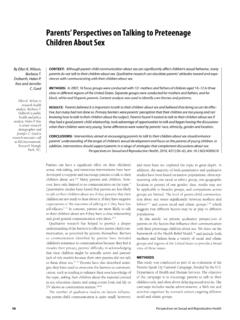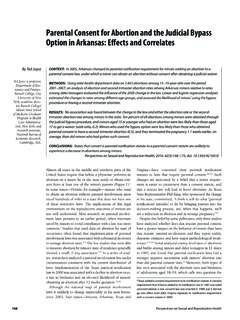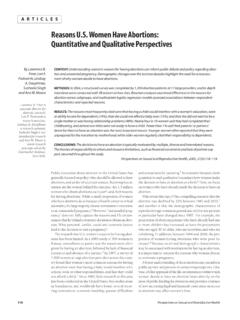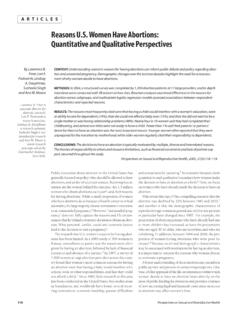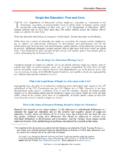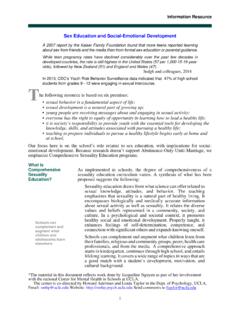Transcription of Factors Associated with the Content of Sex Education In U ...
1 261 Volume 35, Number 6, November/December 2003As in most other countries, men and women in the Unit-ed States typically begin having sexual intercourse duringlate adolescence: at a median age of years for men for make healthy and responsible deci-sions about whether to have intercourse and how to pro-tect themselves and their partners from unwanted preg-nancies and sexually transmitted diseases (STDs), youngmen and women need relevant information and organizations such as the American MedicalAssociation, the American Academy of Pediatrics and theNational Academy of Sciences have recommended thatschools implement comprehensive sex Education strate-gies. Such strategies not only teach students that abstinenceis the best way to prevent unintended pregnancy and STDs,but also provide students with the information and skillsthey need to reduce their number of partners and to usecontraceptive and disease prevention methods effectivelywhen they become sexually contrast, federal legislation since the late 1990s hasfunded abstinence-only programs, which promote absti-nence exclusively.
2 Such legislation explicitly excludes ad-vocating contraceptive use or teaching about contraceptivemethods, except to stress their failure Abstinence-only programs gained prominence in 1998, when Section510 of the Social Security Act began providing $50 millionin annual grants, to be matched with $ million annu-ally in state funds. In almost every jurisdiction, programsfunded under Section 510 support school-related Section 510 was established, two other federalprograms the Adolescent Family Life Act and the mater-nal and child health block grant s Special Projects of Re-gional and National Significance have specified that theirfunds cannot be used to discuss contraceptives, except toemphasize their failure comprehensive sex Education and abstinence-only Education are often contrasted against one another inpolicy arenas,7the way in which these approaches are im-plemented in the nation s schools is largely unknown.
3 Inthis article, we report findings from our analysis of data froma nationally representative survey of sex Education teach-ers in schools that examined whether and how absti-nence, contraception and other topics were Education IN SCHOOLSSex Education is taught in almost all public secondaryschools in the United States (93%); more than 95% of15 19-year-olds have had sex Education , the Content of sex Education notably, the emphasisteachers give to abstinence and their coverage of the effec-tiveness of contraceptive methods varies Associated with the Content of Sex EducationIn Public Secondary SchoolsCONTEXT:While sex Education is almost universal in schools, its Content varies considerably. Topics such as absti-nence, and basic information on HIV and other sexually transmitted diseases (STDs), are commonly taught; birth con-trol and how to access STD and contraceptive services are taught less often.
4 Factors potentially Associated with thesevariations need to be : Data on 1,657 respondents to a 1999 national survey of teachers providing sex Education in grades 7 12were assessed for variation in topics covered. Logistic regression was used to ascertain Factors Associated withinstruction on selected : The Content of sex Education varied by region and by instructors approach to teaching about abstinenceand contraception. For example, teaching abstinence as the only means of pregnancy and STD prevention was morecommon in the South than in the Northeast (30% vs. 17%). Emphasizing the ineffectiveness of contraceptives was lesscommon in the Northeast (17%) than in other regions (27 32%). Instructors teaching that methods are ineffective andpresenting abstinence as teenagers only option had significantly reduced odds of teaching various skills and topics(odds ratios, ).CONCLUSIONS: Instructors approach to teaching about methods is a very powerful indicator of the Content of sexeducation.
5 Given the well-documented relationship between what teenagers learn about safer sexual behavior andtheir use of methods when they initiate sexual activity, sex Education in all high schools should include accurateinformation about condoms and other on Sexual and Reproductive Health, 35(6):261 269By David J. Landry,Jacqueline , SusheelaSingh and JennyHigginsDavid J. Landry issenior researchassociate, JacquelineE. Darroch is seniorvice president and vicepresident for science,and Susheela Singh isdirector of research, all at The AlanGuttmacher Institute(AGI), New York. Atthe time this articlewas written, JennyHiggins was researchintern at on Sexual and Reproductive HealthA 1998 survey found significant regional differences inschool district policies on whether sex Education shouldbe taught and, if so, how abstinence and contraceptive meth-ods should be percent of schooldistricts had a policy to teach sex Education .
6 In 35% of thesedistricts, the policy was to teach abstinence as the onlypositive option outside of marriage, and to highlight theineffectiveness of methods for preventing pregnancy andSTDs (if these methods were covered at all). Among dis-tricts with a policy, those in the South were significantlymore likely than those in other regions to require teachingabstinence as the only option for unmarried teenagers (55%vs. 20 35%). These differences in policies raise questionsabout whether regional patterns exist in instructors ap-proaches to teaching about abstinence and contraceptivemethods including whether they teach specific skills differences in contextual Factors , such as localpublic opinion on teaching students about birth controland STD prevention, may help explain variations in sexeducation instruction. Analyses from the General SocialSurvey have demonstrated that adults living in the Southtypically have less permissive attitudes about sexuality thando those in other regions (as gauged by attitudes towardpremarital and extramarital sex, and homosexuality).
7 Thismay reflect more traditional values and attitudes generallyamong Southern residents, and a relatively high proportionwho belong to fundamentalist religious region s proportion of youth who are sexually active,and its pregnancy rate relative to other regions, also maybe related to the Content of sex Education ; however, rela-tionships are likely to be complex, and their direction hardto identify. For example, relatively low rates of teenage sex-ual activity and pregnancy may reflect a region s lower needfor sex Education compared with other regions , or theymay result from more widespread sex Education . Similar-ly, a relatively high STD prevalence among adolescents mayincrease community support for sex Education or may re-flect deficits in current between the United States and other coun-tries might help inform our understanding of regional pat-terns in the United States. In many Western, developedcountries with adolescent pregnancy and STD rates lowerthan rates, there is not only greater societal acceptanceof sexual activity among teenagers, but also more com-prehensive and balanced sex Education and greater accessto condoms and other forms of birth , re-gional variations in the United States in societal acceptanceof sexual activity among adolescents and approval of sexeducation could be Associated with differences in what istaught in other than region and instructors approach toteaching abstinence and method effectiveness may also berelated to the Content of sex Education classes.
8 For example,health educators receive more training in sex Education thanphysical Education teachers , because schoolswith a large student enrollment or a high proportion of im-poverished students generally have a relatively high pro-portion of sexually active students, they may receive in-creased support from officials and the local community forinstruction on birth control and STD this article, we establish a context in which to un-derstand regional patterns of sex Education , and we reportsurvey findings on how instructors approach the teachingof abstinence and method effectiveness, according to re-gion. We also examine differences in the proportion of in-structors teaching 27 selected topics and skills, accordingto region and to a measure of how instructors teach absti-nence and method effectiveness. Finally, we examinewhether region, teaching approach and other Factors areindependently Associated with the proportions of in-structors teaching selected key topics and skills related topreventing sexual behavior, pregnancy and STDs, and toaccessing contraceptives and STD and Survey of TeachersWe analyzed data collected by The Alan Guttmacher In-stitute (AGI) in a 1999 nationally representative survey ofpublic school teachers of grades 7 12 who are responsiblefor the subject areas that usually include sex Education biology, health Education , family and consumer science (alsoknown as home economics), and physical Education andschool nurses.
9 In all, 3,754 teachers responded to the survey,representing 49% of eligible participants. Our analysis isbased on the 1,657 respondents who had taught sex edu-cation in the current or preceding school year. Market Data Retrieval supplied a systematic random sam-ple of teacher names, stratified by teaching specialty; theircompany also provided data on each teacher s school, in-cluding state, number of students enrolled and the pro-portion of students living in poverty. More information aboutthe survey methods has been described measure how a teacher approached abstinence, thesurvey asked, Which one of the following best describesthe way you teach about abstinence from intercourse in yoursexuality Education instruction? Respondents couldindicate that they presented abstinence as one alternative,as the best alternative or as the only alternative for preg-nancy and STD prevention, or that they do not teach aboutabstinence.
10 *Instructors approaches to teaching about condoms andbirth control were assessed through two questions. First, Which one of the following best describes the way youteach about condoms in your sexuality Education instruc-tion? Respondents could indicate one of three options:They emphasize that condom use can be an effective meansof preventing STDs among sexually active persons, theyemphasize that it is ineffective, or they do not teach aboutcondom use to prevent STDs. The second question asked, Which one of the following best describes the way youFactors Associated with the Content of Sex Education *Questionnaire items about STDs usually used the term STDs/HIV. In thisarticle, we have generally shortened the term to STDs. 263 Volume 35, Number 6, November/December 2003 RESULTSV ariations in Context In 1999, one-third of Americans believed that sexual in-tercourse should occur only in marriage (Table 1); the pro-portions in the Midwest and South (34% and 40%, re-spectively) were higher than those in the West andNortheast (29% and 26%, respectively).
